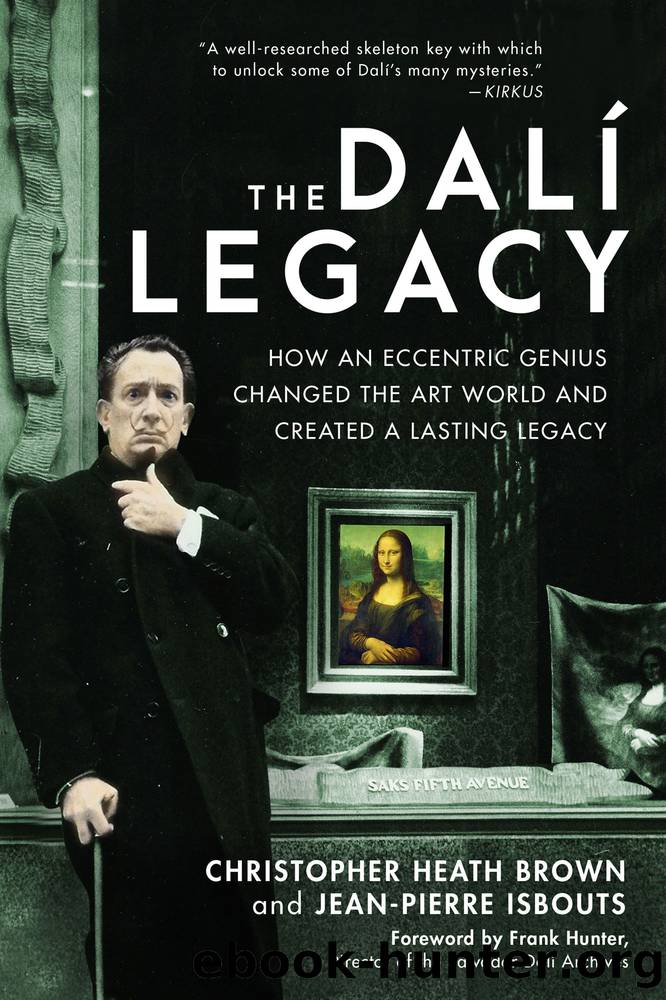The Dali Legacy by Christopher Heath Brown

Author:Christopher Heath Brown
Language: eng
Format: epub
Tags: Art History
Publisher: Apollo Publishers
Published: 2021-01-04T00:00:00+00:00
Fig. 64. Salvador DalÃ, Endless Enigma, 1938
This only pushed Dalà to produce ever more provocative works that would establish him as the leading light of Surrealism, even if much of the Surrealist movement had by now disowned him. It also compelled him to write furiously, defending himself and his art. This led in 1942 to his first autobiography, The Secret Life of Salvador DalÃ.
His standing in the New York art world received a major boost when in November of 1941, the Museum of Modern Art hosted a major retrospective exhibition of DalÃ, with some additional works by Miró. The exhibit subsequently traveled throughout the United States and did much to cement DalÃâs reputation in this country. In the introduction to the accompanying catalog, MoMA publicist Monroe Wheeler wrote that âwe believe that Dalà is an artist of the greatest interest at the moment, and meaningful in this historic sense,â because âhis imagination is not abnormal, at least no more so than that of a number of geniuses of painting in the past; no more so than the tormented psyche of today which is its basic theme.â And while DalÃâs conduct âmay have been undignified,â Wheeler continues, âthe greater part of his art is a matter of dead earnest, for us no less than for him.â
The subsequent essay by MoMA curator James Thrall Soby readily acknowledged the influence of Old Masters such as Johannes Vermeer, Diego Velázquez, Hieronymus Bosch, and the Spanish and Italian Baroque. In fact, Soby called DalÃâs interest in Vermeerâs art no less than âobsessive,â noting that âat various times in his career, [DalÃ] declared that his ultimate ambition is to be able to paint like Vermeer.â
Notwithstanding the prestige of this retrospective, as well as the attention that the American press continued to lavish on DalÃ, the sales of his paintings gradually declined after the United States entered World War II following the Japanese attack on Pearl Harbor. As the wealthy patrons of New York turned to funding the war effort, the idea of investing in Surrealist art by a Spanish painter receded in importance. In response, Dalà plunged himself into writing, producing a novel, Hidden Faces, in 1944, while being forced to accept commissions to paint portraits of New York socialites. Needless to say, this further dimmed his standing in Modernist circles. Indeed, even the most passionate devotees of DalÃâs art would admit that the war years in exile were not the artistâs most fertile period, with only a few works of genuine merit. By contrast, Dalà produced some of his best designs for the stage during this time, including the sets for the 1941 ballet Labyrinth at the Metropolitan Opera, and the 1944 ballet The Mad Tristan, choreographed by Leonide Massine based on Richard Wagnerâs opera Tristan und Isold.
Download
This site does not store any files on its server. We only index and link to content provided by other sites. Please contact the content providers to delete copyright contents if any and email us, we'll remove relevant links or contents immediately.
Technical Art History by Jehane Ragai(230)
The Slavic Myths by Noah Charney(187)
Drawing Landscapes by Barrington Barber(173)
Simply Artificial Intelligence by Dorling Kindersley(164)
Drawing for the Soul by Zoë Ingram(157)
The Art of Painting Sea Life in Watercolor by Maury Aaseng Hailey E. Herrera Louise De Masi and Ronald Pratt(150)
Compacts and Cosmetics by Madeleine Marsh(145)
The Art of Portrait Drawing by Cuong i(145)
Preparing Dinosaurs by Wylie Caitlin Donahue;(139)
Egyptian art by Jean Capart(133)
A text-book of the history of painting by Van Dyke John Charles 1856-1932(127)
Winslow Homer by Shibutani Baku(123)
Through Japan with Brush & Ink by Chiura Obata(108)
Pornoterrorism: De-Aestheticising Power by Louis Armand Jaromir Lelek(103)
Botanical Illustration by Valerie Price(102)
Culture and Ideology under the Seleukids by Eva Anagnostou-Laoutides Stefan Pfeiffer(102)
Jane Evans. Chinese Brush Painting. A Complete Course in Traditional and Modern Techniques by Unknown(94)
The Dali Legacy by Christopher Heath Brown(92)
Medieval and Renaissance Fashion by Raphaël Jacquemin(91)
